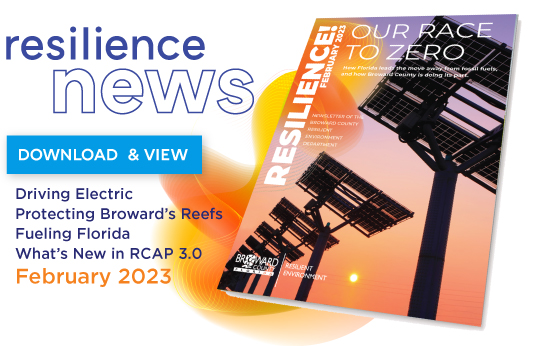
NATURAL RESOURCES DIVISION NATURAL RESOURCES SPECIALIST
STEVEN BEDOYA REVIEWS CHARGING HIS EV FOR HIS WORK COMMUTE.
Before my first day with Broward County I was reviewing my commute options, I asked what the routine commute and most employees drove. Since I drive an electric vehicle (EV) I needed to find a way to charge in case I needed some ‘fuel’ to make my route.
Back in 2019 my wife and I would commute to work via public transportation. Unfortunately, due to school schedules for the little one and after-care hours, we had to switch to driving. This meant that we had to pay tolls on multiple expressways, pay for parking, along with fuel costs which increased our commute costs. I had been considering an EV for some time, as traditional auto manufacturers didn’t have any long-range options. I ‘needed’ 300+ miles, therefore we went to Tesla. We test-drove a few models and fell in love with the Model 3.
The purchase cost was more than our typical vehicle so since we were commuting together anyway, we switched from being a multi-vehicle household to a single-vehicle household. The benefit of no fuel or maintenance helped as well. Eventually, with the pandemic, we started working remotely and seldom used our new EV, but once I made the move to Broward County I started my commute research. In my first week, I started inquiring about the EV charger.
First I registered with parking program to gain access to Governmental Center East 2nd-floor parking area where the charger is located. It’s great as an employee benefit and knowing it’s part of the multiple renewable energy projects and initiatives the County has. It turns out there is a schedule for using the charger, not first come first serve like my previous employer. There are plans to expand the number of chargers in the employee garage in the future, and it’s needed as some users need the daily charge to make it back home on their commute. With the 4-hour charge session, I’m thankfully able to cover most of my weekly commute and I trickle charge at home with the 120V.
Since my EV does have a longer range, I plug it in like a cellphone and home and I’m able to travel to Orlando with no issues. The Tesla Superchargers allow me to make quick stops, as we grab food or the kids use the bathroom, and we’re able to continue our trip. Tesla Superchargers use the North American Charging Standard (NACS) connector and charge your car up to 200 miles in 15 minutes. When I’m planning vacations I try to stay at hotels that have destination chargers that allow me to charge my car overnight so I can use it in my travels. There’s nothing better thing than having a full car when you wake up!
The cherry on top of owning an EV is I’m currently in the permitting stage for solar and battery installation at home, so my EV will be fully powered by the sun. After a $500 electricity bill during the hot summer I immediately signed up for solar. Now I’ll end up with a $25 electricity bill and backup power during hurricanes.
I try to do my part for the environment every chance I get.
I’ve been a pescetarian for 8 years, am fully digital in my personal and work life to limit paper use. I’m a volunteer with Solar United Neighbors (SUN) to advocate for going solar, I’m a member of Tesla Owners South Florida as I try to advocate for the environment at all times in various events throughout the year. Hopefully, my story gets someone thinking about a little change in their life. As more of us make those choices, it all adds up to a cleaner environment.

